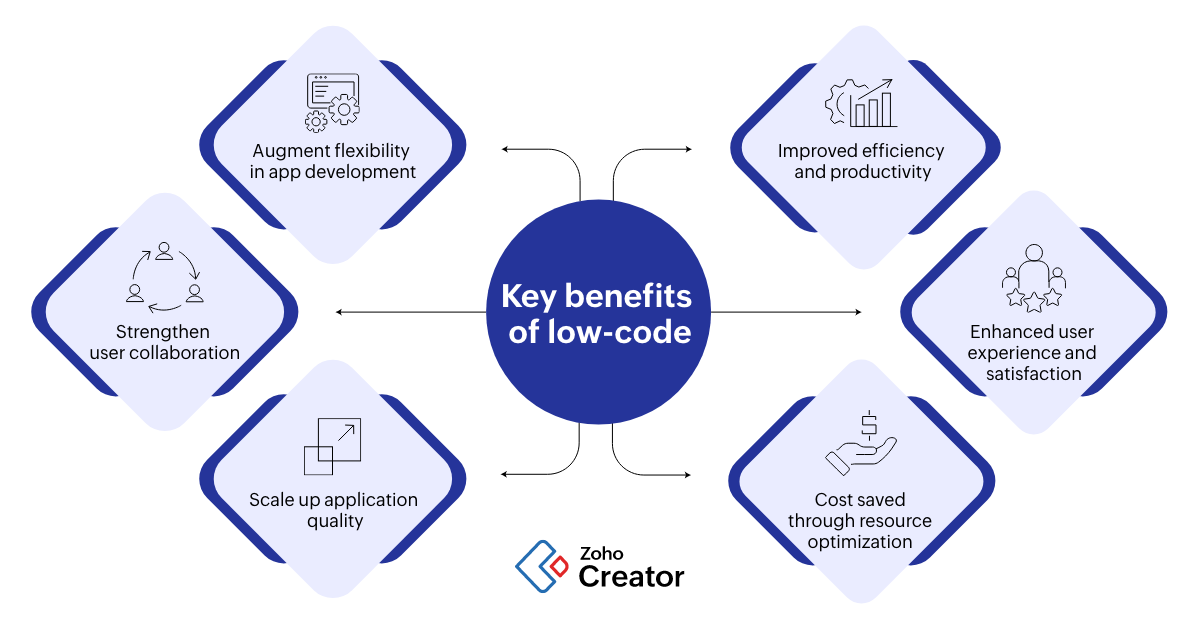Integration of low-code applications offers a variety of advantages, including the capability to seamlessly integrate multiple platforms and services. Here are some of the major advantages of Pre-built connectors and APIs.
Many Connectors to Choose From Low-code platforms generally include a wide range of pre-built connectors for popular enterprise systems (e.g., CRM, ERP and cloud services such as databases,). The process of integrating these systems is made easier.
API Integration: Many Low-Code platforms come with out-of-box API integration capabilities, which allow developers to effortlessly connect external services as well as data resources.
Simple to use:
Drag-and-Drop Integration: Integration tasks can often be done using drag-and drop interfaces, making it accessible for both developers and non-developers to design complex integrations, without writing lots of code.
Visual Workflow Builders Visual Workflow Builders: These tools can be used for designing workflows, data flows, and integrations. They aid in understanding and setting them up more efficiently.
Standardized Integration Methods:
SOAP/RESTful Services Support: Web services that use standard protocols, like SOAP/REST, allow for easy integration of a range of external applications and systems.
OData Standards and other Standards Support for standards, including OData permits easy access to data and its manipulation across multiple platforms and applications.
Real-Time Data Synchronization:
Real-Time Integrations: Low-code platforms can handle real-time data transfer between systems and applications. This guarantees that data is up to date and consistent throughout the organization.
Event-Driven Architectural: Some platforms have event-driven architectural designs, allowing applications to respond in real-time, to events essential for interactive, dynamic applications.
Legacy System Integration:
Low-code platforms are often employed to integrate systems from the past. This enables organizations to modernize IT infrastructures without the need for a complete overhaul of the existing systems.
Data Migration Tools Data Migration Tools aid in the transfer of data from outdated systems to new applications built on low-code platforms.
Third-Party Integration of Service:
Cloud Services Integration: The seamless integration of cloud services like AWS Azure, Google Cloud, allows for easy deployment and scaling-up of applications.
Integration of Business Applications: Lowcode platforms can be used to integrate various business applications like Salesforce, SAP, Microsoft Dynamics etc. to create a seamless workflow that spans different functions of business.
Simplified Data management:
Unified Data Models: A few low-code platforms have unification of data models which make it easier to manage data management and integration across different systems.
Data Connectors Data connectors that are pre-configured enable users to access and manipulate data from many sources.
Security and compliance
Secure Integrations: Low code platforms ensure that integrations are compatible to security protocols as well as standard, protecting data during transport as well as at rest.
These platforms are often packed with features to in ensuring compliance (e.g. HIPAA, GDPR) and offer assurance to companies dealing with sensitive data.
Extensibility:
Custom Code and Scripts: Low-code platforms are often able to handle more complicated integrations by allowing the inclusion of scripts and custom code. This allows for flexibility without compromising ease of usage.
Plug-in Ecosystems: A plug in ecosystem can be used to expand the capabilities of integration and permit users to expand the functionality when needed.
Overall, integration capabilities within low-code application development platforms permit them to function as a strong platform for creating interconnected and scalable, efficient and interconnected applications. They simplify the process of linking disparate systems. They enhance data flow, and enable enterprises to use existing technologies while incorporating new ones, thereby ensuring the integration of a seamless IT environment. Take a look at the recommended https://www.wavemaker.com/low-code-application-development-platform/ for website recommendations including application development platforms, rad development, rad development, multiplatform mobile app development, application modernisation, app platforms, lowcode no code, low code development platforms, push notifications, stored sql procedures and more.

Benefits Of Application Development With Low-Code In Security And Governance
Low-code application design offers many advantages in terms of governance and security. Both are vital to making sure that apps remain in compliance, safe and well-managed throughout their lifecycle. Here are some of the most important benefits:
Unified Manage Console: Lowcode-based platforms generally provide a management console allowing administrators to supervise and manage applications.
Role-Based Access Control RBAC: These platforms have robust role-based controls that allow administrators to define access policies. Only authorized users will be allowed to modify and access certain areas of the application.
Compliance and Regulatory Application:
A lot of low-code platforms have integrated compliance features. For example, they are designed in accordance with the standards of the industry regulations, laws and standards (e.g. HIPAA, GDPR). They offer frameworks and instruments to ensure that applications comply with requirements.
Audit Trails: Many organizations integrate comprehensive logging and audit trail systems, which enable them to monitor changes make, track access and assure the compliance of internal and external rules and regulations.
Additional Security Measures
Data Encryption : Low-code platform usually provide data encryption built-in in transit and at rest. This means that sensitive information will be protected.
Security Certifications: Many providers of low-code services have security certificates such as ISO 27001 or SOC 2 to prove that they are able to meet the highest standards. These certificates provide an additional level of security to customers.
Automated security updates
Regular Patching and Updates Lowcode platforms typically provide regular security updates. These patches guard software from the latest threats without requiring developer intervention.
Security Monitoring: Continuous security monitoring tools are typically used, which provide real-time alerts and insights into security risks that might be present.
Data Governance
Data Access policies: These platforms help organizations determine and enforce their data access policy to ensure that only authorized users have access to information and that it's being used appropriately.
Data Masking, anonymization, and Anonymization Tools: These programs can help safeguard sensitive personal data and are particularly useful in test environments.
Consistent Lifecycle Management of Applications:
Development and Deployment pipelines Lowcode platforms usually offer integrated pipelines for development and deployment that include security tests. They provide security throughout the entire lifecycle of an application.
Version Control - Integrated version controls help keep track of modifications to applications and allow users to revert them, if required. They also help maintain the integrity and integrity of the software.
Authorization and User Authentication:
Single Sign-On: The support for SSO and other advanced authentication methods eases managing users and improves security.
Multi-Factor Authentication A lot of platforms have built-in multi-factor support, adding additional security to accessing applications.
Policy Enforcement and Compliance Monitoring:
Policy Templates: Low-code platforms typically have pre-defined templates for policies that help organizations quickly implement governance and security policies.
Compliance Monitoring Tools They provide continuous monitoring and reporting about compliance levels, which makes it easier to recognize and resolve possible issues in advance.
Integration into Existing Security Infrastructure:
Seamless Integration: Platforms using low-code have been designed to seamlessly integrate with tools and infrastructure, such as SIEM (Security Information and Event Management solutions) and firewalls.
API Security: Integrated API security ensures integrations with external systems are secured. Keep data safe and ensure application consistency.
Best Practices and Training:
Guided Best Practices: Many platforms offer guidelines and best practices that can help non-developers adhere with security standards.
Certain lowcode companies offer resources and security training for users to help them understand how to build and maintain secure applications.
In general, low-code developers provide a security and governance advantage that allows them to build and manage their applications in a controlled, compliant and secure way. These platforms offer all the tools and frameworks required to safeguard sensitive data and enforce policies, while ensuring regulatory compliance. Read the top rated find out more for Enterprise application development with Low-code Platform for blog tips including mobile app development platforms, push alerts, push notifications, software for app development, develop web app, mobile app development platforms, push notifications, paas service, mobile app development platforms, ms azure sql and more.

Benefits Of Low-Code Application Development In Terms Of Community Support And Vendor Support
Low-code platforms provide significant benefits in terms of community support and vendor support, both of which are crucial to the success in the implementation, maintenance and improvement of apps. Here are the major benefits: Support from the vendor
Comprehensive Technical Support:
Support Teams with Dedicated Support: Many low-code platforms provide access to dedicated support teams who can assist in technical problems, troubleshooting and provide guidance to ensure that issues are addressed quickly.
24/7 Support Some suppliers are available 24/7 and this is helpful for businesses that operate in multiple time zones.
Training and Onboarding
Training programs that are structured: Vendors provide structured courses such as webinars and certification courses. This helps users to quickly get to grips with the platform.
Many vendors provide personalized onboarding to help customers utilize the platform effectively and adapt it to the needs of their customers.
Regular Updates and Enhancements
Continuous Improvement: Low-code platforms regularly release updates that include new features, security patches, and improvements to performance. This makes sure that the platform is always updated and safe.
Feedback Integration: Many vendors integrate user feedback into their development cycles. This helps ensure that the platform adapts to the ever-changing needs and wants of its customers.
Comprehensive Documentation:
Detailed Documentation: Extensive and well-organized documentation is typically available that covers everything from the basics of use to advanced customization, which assists users in finding solutions independently.
API References API documentation can assist developers customize and integrate applications using the Low-Code platform.
Professional Consulting Services
Expert Consulting: Most vendors provide consulting services for architectural planning, strategic planning and complicated implementations. This helps users maximize their platform's potential.
Custom Development Service: A few vendors will offer customized development to develop functionalities or integrates for their customers which are not readily accessible.
Community Support for the Community
Active User Groups:
Forums and Discussion Panels: Many Low-code platforms feature vibrant online communities where users can ask questions, debate strategies, and even collaborate on best methods.
User Groups and Meetups: Virtual and local user groups and meetups provide opportunities to meet, network, and sharing experiences with other users.
Knowledge sharing and collaboration:
Community-Contributed Resources: Users often share templates, modules, and extensions that they have developed, which can be reused or adapted by others, accelerating development and innovation.
Crowdsourced Problem-Solving: The collective wisdom and collective knowledge of a community can be a valuable help to resolve issues and discover creative solutions to complex problems.
Development and learning:
Community-led training A lot of community groups offer workshops, webinars, and workshops facilitated by experts who are experienced in the area.
Online Tutorials and Courses The community members frequently share and create online tutorials, classes and tutorials for how to perform tasks that help students learn more.
Feedback and Influence:
Community Forums are often a place where vendors can get feedback from the community. The feedback can be utilized to design new features or improve the functionality of.
Beta Testing Programs. Active community members can participate in beta-testing programs. They will get an early introduction to the new features of the platform and the chance to influence the evolution of the platform.
Recognition and Support
Community Recognition Programs: Many companies offer recognition programs to active members of the community. Examples include MVP (Most Valuable Professionals) which acknowledges their contributions.
Support from peers: Community members will often offer support to peers, providing their knowledge and guidance to those who may be less knowledgeable. They create a more collaborative atmosphere by encouraging collaboration and a supportive atmosphere.
Overall, the combination of robust support from the vendor and an active and engaged community creates an entire support network for the development of low-code applications. This ensures that users have the expertise, resources, as well as collaborative opportunities, they need to successfully develop and implement their apps.
